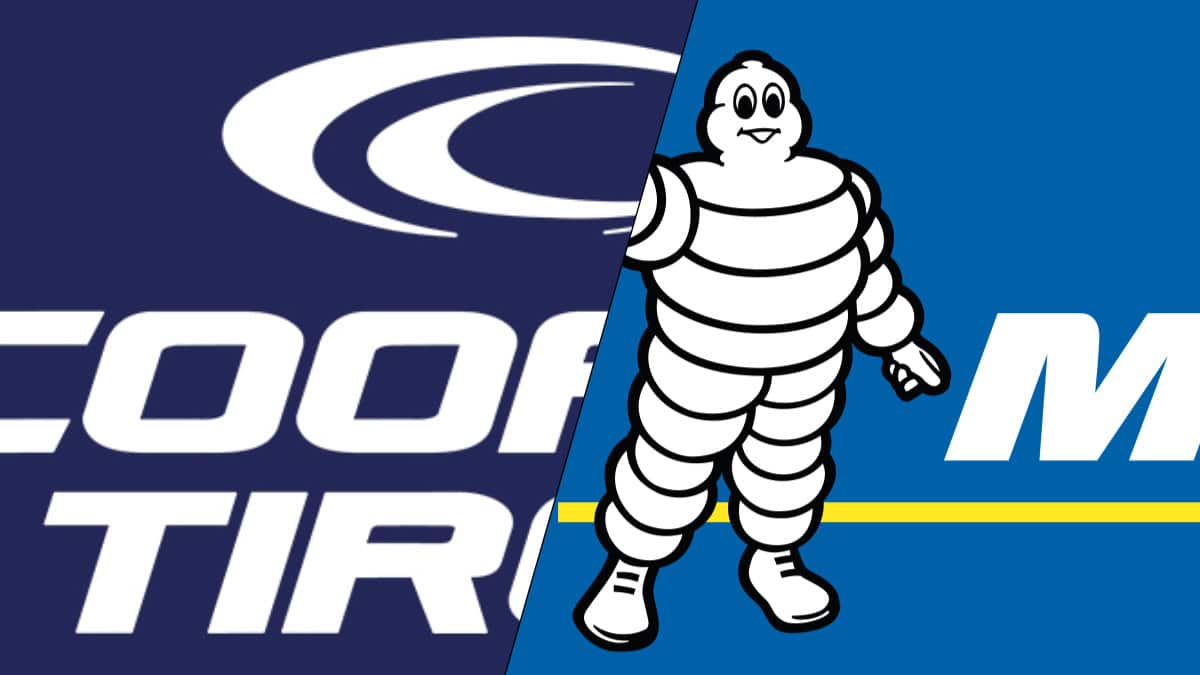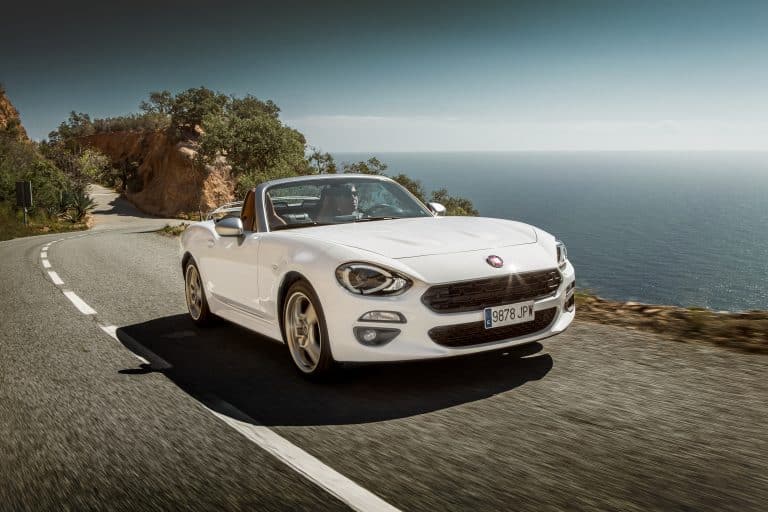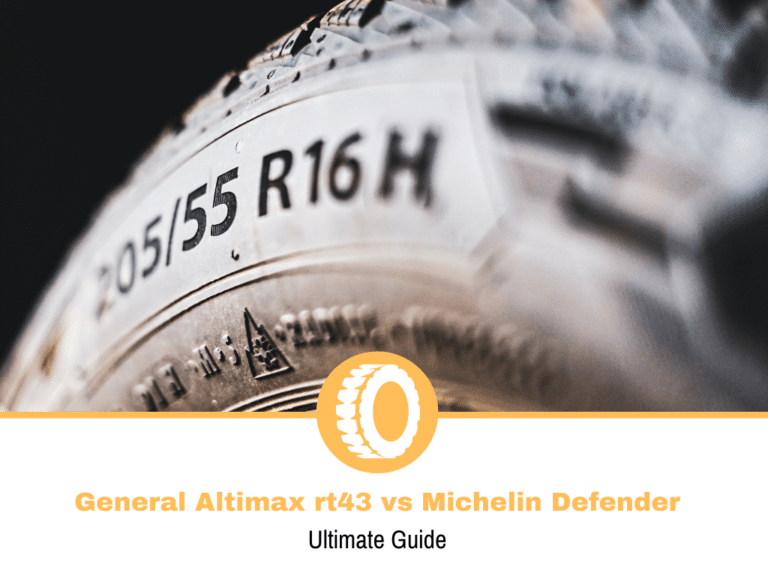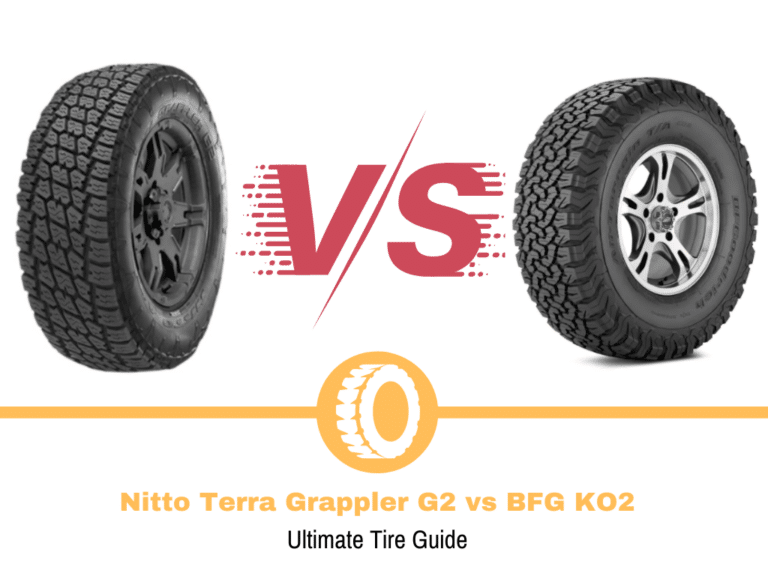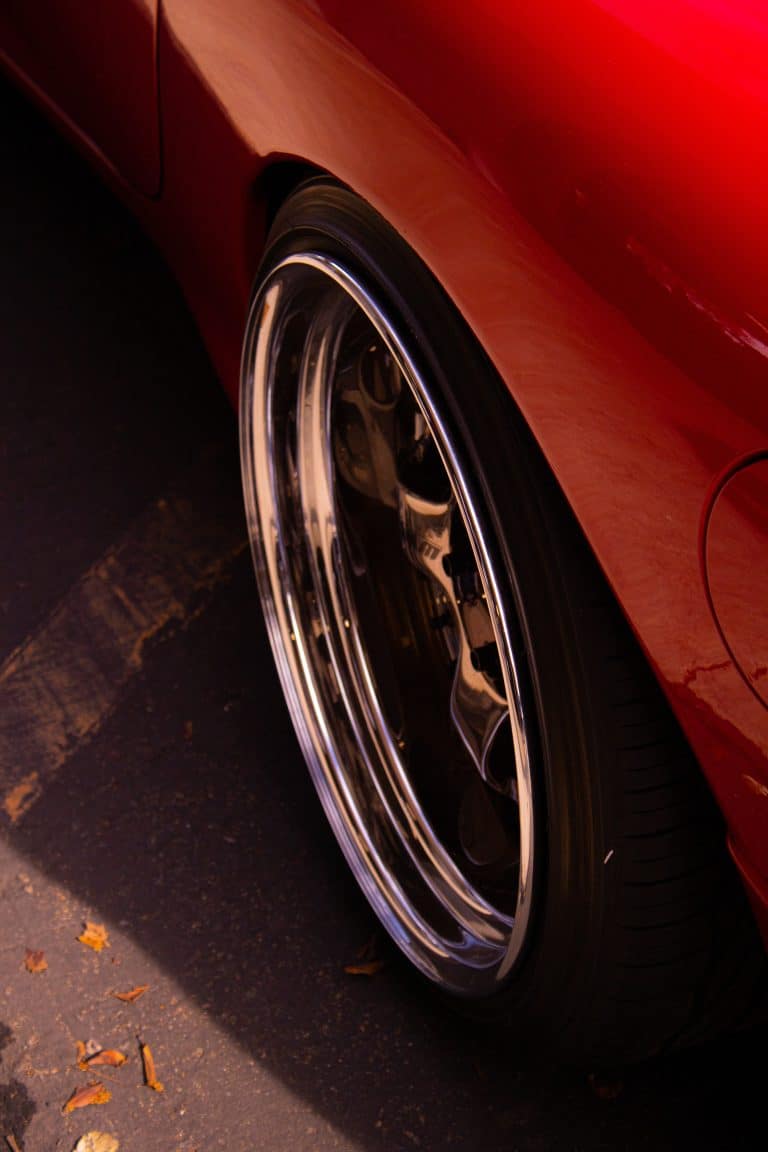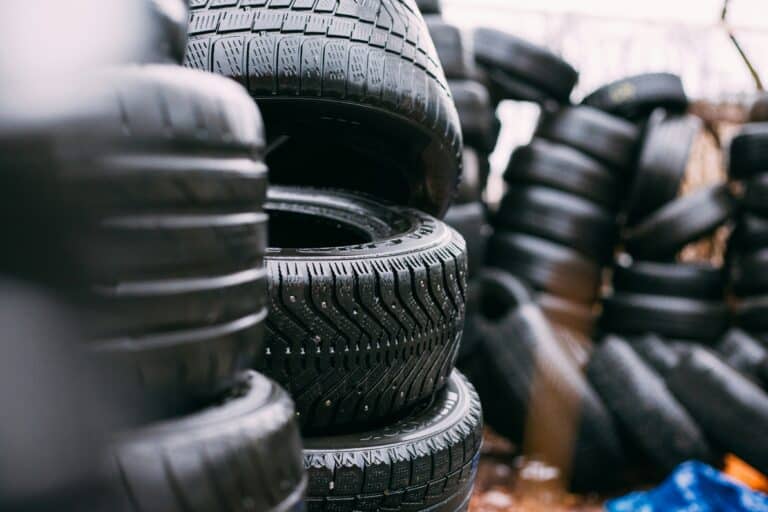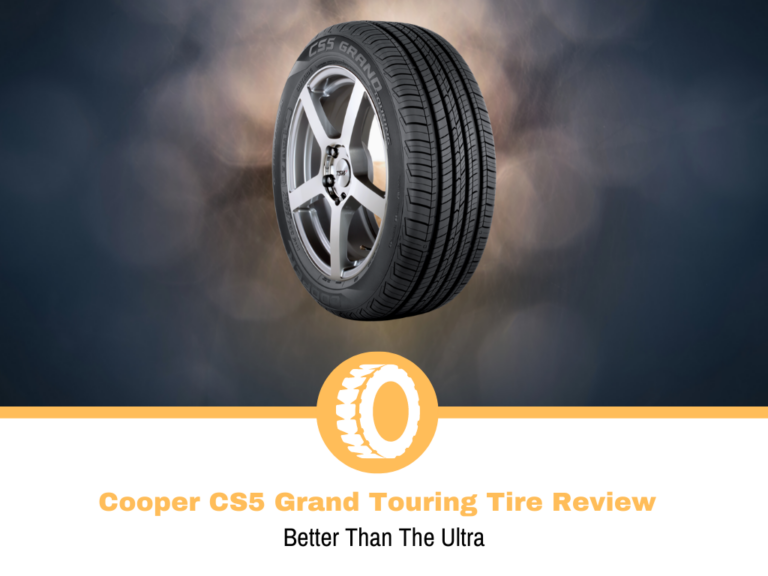Cooper vs Michelin Tires
Making the right choice in terms of tires is a process that most people have some difficulties with. Considering the amount of available tires on the market, it’s not something that should surprise you.
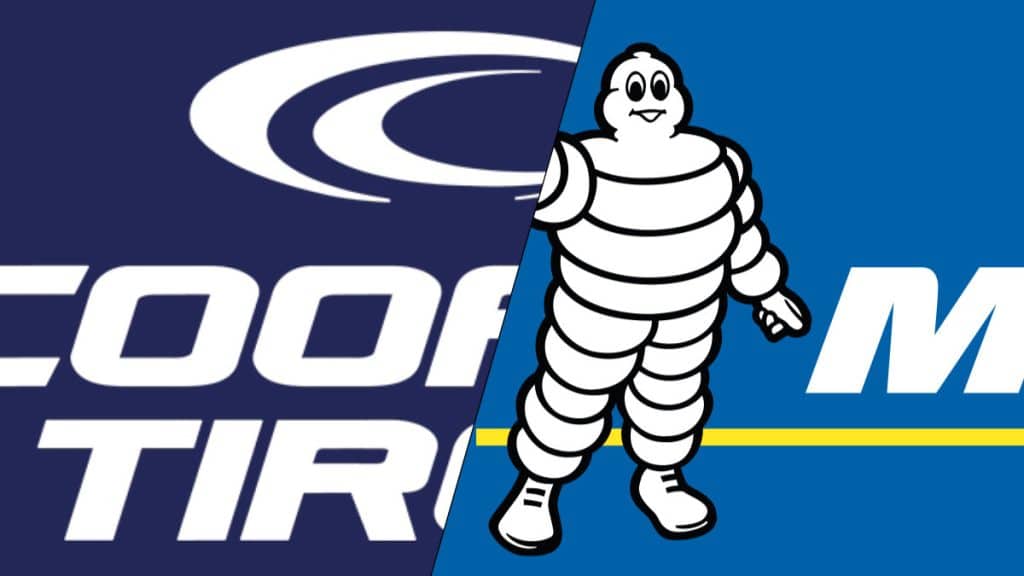
Cooper Rating: 4.5/5
Michelin Rating: 4.7/5
Most of us would always like to get the best of the best, but the budget often plays a huge role. Combine this with the fact that some of us don’t need the most expensive tires, and we come to what today’s comparison is all about. The duel for this comparison comes from two brands that fall into different price categories.
Cooper is a company known for making excellent tires at a more affordable price. Michelin, on the other hand, is a premium brand that makes one of the best tires in the industry, but at a higher price than Cooper.
I’ve reviewed plenty of mid-range tires and was surprised by how close they are in performance compared with the premium options. In some cases, I even found some of them to be a bit ahead of the “expensive” competition.
With that in mind, I’ll be looking at how the tires from these two brands compare and which one could be a better option for you.
Cooper’s history
Out of these two, Cooper is the younger company by a few decades. The company was founded in 1914 in Akron, Ohio, but it was known as M and M Manufacturing in those days. Initially, the company’s product lineup consisted of rubber products like cement, repair kits, or patches.
Several years after it was founded, the founders purchased Giant Tire & Rubber Company, moving its headquarters to Findlay. Until this point, the company was more or less a parts dealer for the automotive industry, and once it was merged, the name was changed into Cooper Tire & Rubber Company, effectively switching over to tire production.
Even in the early days of its existence, Cooper aimed to make more affordable tires for the masses without too many compromises in terms of performance. Despite being “marked” as a mid-range option, the company grew despite the stiff competition in the industry. Throughout the years, this meant that the company could purchase some smaller brands and put them under its umbrella. This resulted in Cooper buying companies like Mickey Thompson, Avon, and Mastercraft.
You think, what does a mid-range brand has to show for? Quite a lot, actually. Despite not being crowned as the best in the industry, Cooper is a brand that continuously aims to improve the products it has. The result of this is what I explained in the beginning – excellent tires at a more affordable price.
Initially, Cooper was the brand that seemed to be happy to be there, and despite its success in the road tires, it wasn’t too interested in racing. This changed in the past decades, and the company began to take an interest in racing. As a result, the company has been involved in Rallycross, Indy Light, Ima Prototypes Lites, and a few other series.
Cooper’s tire families
In terms of categorizing the tires and the families, Cooper uses a traditional approach you’ll find with most of the companies on the market. For the most part, the families are set based on the application and use case, making things easier to choose.
Endeavor
Touring tires are the most popular option for most people, so I’ll start off with Endeavor. Cooper’s answer to the refined and long-lasting tires comes in the form of this family, covering a wide range of vehicles. On top of that, you also get tires that won’t lack the grip and traction, so there isn’t a massive sacrifice being made here.
At first glance, you may think that 3 models aren’t a lot, but considering the number of sizes they come in, it’s plenty. The Endeavor and Tour models are the ones made for passenger cars, while for CUVs and SUVs, you have the Plus model. Also, all 3 options are all-season tires.
CS
When you compare the CS family of tires with the Endeavor, you’ll find many similarities. Both are designed to be refined and long-lasting while providing some decent performance.
Unlike the previous family, this one has more options, which broadens the choice options, especially in terms of pricing. You can get them in models from CS1 to CS4, CS5 Grand Touring and Ultra Touring, and CS7. Thanks to the wider range of size options, these can be fitted to a wider range of vehicles, and as all-season tires, you’re looking at performance throughout the year.
Zeon
Let’s put the touring tires aside for a minute and talk about performance, like the ones you’d get from the Zeon family. These tires are designed with performance in mind, so you will be getting very high levels of grip and traction at a slight cost of comfort.
The Zeon family of tires is pretty straightforward as far as passenger cars are concerned. There are the RS3-G1, RS3-A, and RS3-S with a slightly different set of features. CUV and SUV owners will need to look at the LTZ, but it’s not a traditional performance tire. This model is also an all-terrain one, meaning that some light off-roading is a possibility. As for the weather conditions, you can get the Zeon tires in summer or all-season variants.
WM
So far, the families of tires I mentioned included summer or all-season models, but this is a winter one. Apart from the improved performance in snowy conditions, these models are also considered to be a bit on the sporty side.
The WM offers the SA2+, a tire designed for passenger cars only. Due to the sizes and specifications, there are two sub-models. The first one is the model with a T speed rating, which is for the smaller sizes, while the larger ones come with an H or V rating. Cooper also offers the WM with a Van model, which can be utilized on a light truck or an SUV. Unlike the SA2+, the Van tire can be fitted with studs.
WeatherMaster
Next up is the WeatherMaster, a family of tires with several similarities with the previous one. The key difference with these models is that you should only look at them if you’re driving an SUV or a light truck.
In terms of actual models, the WeatherMaster can be found as WSC or WSC 4×4. The set of features is identical, both being studdable winter tires. Generally speaking, there is one difference, and that’s in the available sizes. The regular model is for CUVs and SUVs, while the 4×4 is for light trucks.
Discoverer
Some say that the Discoverer family of tires is the one that Cooper aimed to make the widest. Within this group, there are tires for multiple weather conditions and performances. As a result, there are summer, winter, and all-season options combined with touring, winter, performance, and off-road tires.
For passenger cars, Cooper offers the Discoverer All-Season and Winter, which is quite a wide coverage. On the CUV and SUV segment, the company has the XLT, AT3 Sport, AT3 LT, and ATT, some of which are also all-terrain options. Finally, for the mud-terrain ones, you have the STT PRO and S/T MAXX.
Evolution
The Evolution family of tires is one that seems to offer more or less similar options to the previous one. Despite having fewer model options, this group of tires can cover a wide range of applications, just like the Discoverer.
The widest coverage comes from the Tour and Winter models for anything from passenger cars to SUVs. Next up are the H/T and M/T, where the first one is a highway tire for light trucks or larger SUVs. The second model is the mud-terrain tire for off-road capable vehicles.
Cobra Radial G/T
The Cobra Radial G/T isn’t a family of tires, but it’s a single tire. The reason I include it is because it’s designed for muscle car owners, especially the older ones.
It’s an all-season tire with decent performance levels, but the main advantage is how it looks. Cooper managed to keep the retro style of the tire, making it look like it’s from 5 decades ago.
Trendsetter SE
Despite being a more affordable manufacturer, Cooper takes things up to another level and makes the Trendsetter SE. This tire is designed for older cars and people who won’t benefit from getting a premium one.
While the performance isn’t something that can put it at the top, the Trendsetter SE is a tire that comes in smaller sizes. As a result, people that drive cars from the 80s and 90s will have no problem finding the right size.
Michelin’s History
In the premium corner, we have the French tire manufacturer, Michelin. The company was founded in 1889 in Clermont-Ferrand by the Michelin brothers. It kicked things off when the founders wanted to make a removable bicycle tire, which would shorten the time it takes to replace it, thus reducing costs.
With bicycle tires being the first product Michelin made, the company’s success began to increase despite being younger than some of its competitors. While still in its infancy, the manufacturer made a tire for a long-distance bicycle race, which was the winning one despite some doubts. Around that time, the car industry was slowly evolving, so Michelin took that road and started making car tires.
The years spent developing tires helped the company grow and position itself at the top. Climbing the ladder wasn’t easy, and Michelin threw everything it got, which resulted in some innovations and the introduction of new technologies.
By implementing those innovations into its tires, Michelin positioned itself as a reputable brand in racing. On top of the bicycle success it had in the early days, later on, the company got on board with Formula 1, WRC, Le Mans, and plenty of other racing series.
One of the reasons why Michelin is as good as it is today is thanks to implementing the technology from the racing series into the road tires. Sure, you can argue that it didn’t have the smoothest growth, but it managed to “hold on” and reach the level of greatness it has today.
Michelin’s tire families
Looking at the families of tires, you can see a similar grouping pattern as with Cooper. This makes for an easier choice because you’ll know which type you’ll be looking for.
Pilot
The first family of tires is also the most popular one. Michelin’s Pilot lineup of tires has positioned itself as the best when it comes to performance. These are the type of tires you’d be looking at if you’re after something that sticks to the road, delivering high levels of grip and traction.
Michelin covers the summer passenger car segment with models like the Sport 4, 4S and 3. For larger vehicles, there is the Sport 4 SUV that comes in larger sizes. On the all-season side of things are the Sport A/S or All-Season 4, which are for passenger cars only. The Alpin lineup covers the winter tires, and there are models for passenger cars and SUVs.
Primacy
With the performance aside, we have the Primacy family of tires, which are the ones most people would get. Unlike the previous family, these are touring tires, meaning that you’ll have a comfortable tire with low noise levels.
Michelin set things up to cover as much as possible with the Primacy tires, leading to plenty of models. With models like the MXM4 and MXV4, LTX, and Tour A/S, the manufacturer already covers a very wide range of vehicles, including CUVs and SUVs, and come in summer or all-season options. There are also models like the Primacy 3 or HP, which are summer tires only.
Premier
Like many other manufacturers, Michelin has more than one family of touring tires. Like the previous one, the Premier models are made with refinement and longevity in mind with decent performance.
Unlike the previous family, here, the options are limited. The A/S one comes in sizes that can be fitted to passenger cars, while the LXT is reserved for CUVs and SUVs. As for the weather conditions, both models are all-season ones.
Latitude
In each of the previous families of tires, Michelin included models or sizes for SUVs and CUVs. With the Latitude, it dedicated an entire lineup of tires for these types of vehicles. To cover as much as possible, it offers several models with different driving characteristics designed for different weather conditions.
Michelin offers the Latitude tires in multiple options, ranging from Tour and Sport to Alpin and X-Ice. For these, you have several sub-models to choose from depending on the weather conditions you need. Also, the driving characteristics can vary from one model to another, which is another thing to consider when choosing them.
X-Ice
Even though Michelin has winter tires in some of the other families, there is also one dedicated for them. The X-Ice lineup of tires is designed with winter performance in mind for various vehicle types. Unlike the Alpin tires, these are leaning more towards the touring segment.
For non-studable tires, you have the Xi2 and Xi3, which can be found in models for passenger cars to light trucks. If you’re after a better performance on the ice, you have the North option, which is a model that also covers a wide range of vehicles and can be fitted with studs.
Defender
We’re returning to touring tires again, and the Defender lineup is another one. Even though they are not designed the same, they are still excellent touring tires that deliver what they’re supposed to – longevity and refinement.
Michelin offers only two all-season models in the Defender lineup. The T+H tire is designed for anything from passenger tires to SUVs, while the LTX M/S is for larger models, like larger SUVs and light trucks.
Energy
Hybrid and electric car owners want tires with low rolling resistance, and Michelin answered their needs with the Energy tires. This is a touring family of tires but is designed to reduce the rolling resistance even more than most of its competitors.
There are 2 model names but 3 options here. The LX4 is an all-season model, while the Saver can be found in summer and all-season variants. As for the sizes, it’s not the widest range here, and for the most part, they can be fitted to passenger cars, making them especially popular for people looking for smaller tires.
CrossClimate
With the introduction of the CrossClimate family of tires, Michelin began to set the benchmark of how a touring tire should be made. Not only did it tick all the right boxes on the touring side of things, but it also didn’t lack in the performance department.
Currently available are the CrossClimate+ and CrossClimate 2, with the original model being very hard to find, as it’s a bit on the old side. Thanks to the size options, you could fit these tires on a wide range of vehicles, from passenger cars to SUVs.
LTX
Last but not least is another family of tires designed for larger vehicles. The LXT may seem like some of the others I’ve mentioned, but there is a slight difference. While the features may seem similar, there is a model here that can do some off-roading.
As an all-terrain tire, Michelin has the A/T2, which comes in sizes for SUVs and light trucks. There is also the M/S2, designated as a highway tire, meaning you’re essentially looking at a touring tire. Both models are all-season ones, so performance throughout the year is possible.
Differences between Cooper and Michelin
Since one of the manufacturers is from the mid-range and the other from the premium segment, a difference in performance should be expected. The real question is how big of a difference we’ll see?
Performance
It’s no secret that Cooper makes excellent tires, and based on the performance results, they are quite close to what Michelin has to offer. Surprisingly, you can find some situations where the US tires can outperform the French ones.
In the all-terrain segment, the Cooper Discoverer AT3 is a tire that can outperform the LTX A/T2 in braking on tarmac. On the other hand, braking on gravel delivers different results. As for the rest of the off-road performance, the premium tire is slightly ahead of the mid-range one.
In the UHP all-season segment, we have the Zeon RS3-G1 and the Pilot Sport All-Season 4, and comparing them shows the slight advantages premium tires offer. Apart from wet braking and comfort, the Michelin tire is slightly ahead, with the biggest difference being in snow conditions. Despite the differences, the tires are relatively close.
Continuing the UHP trend, we have SUV summer models like the Zeon 4XS Sport and the Pilot Sport 4 SUV. In terms of performance, it’s a similar story to the previous comparison. The Pilot Sport 4 SUV outperforms the Zeon 4XS Sport in almost every situation except noise. With that said, I have to give credit to Cooper for making a tire that handles almost as good as the Michelin on dry roads.
On the winter side of things, let’s compare the WeatherMaster SA2 and the Alpin A4, both of which are non-studable tires. In this comparison, the results are a mixed bag. The braking distances of the Zeon in wet and dry conditions are shorter than the Alpin. In the other situations, the Michelin tire delivers better performance than the Cooper one. Despite being a winter tire, the snow performance isn’t spectacular.
Since both manufacturers have studdable tires, we can compare the WeaterMaster WSC and the X-Ice North 4. Unlike the previous comparison, these two tires are much closer, and even though there are some differences, they are marginal.
Available Options
Looking at the available options, it can be a bit difficult to decide which one is generally better. When we dissect each category, we start to see some differences, but they aren’t huge.
In the touring segment, both brands are closely matched. Cooper and Michelin have several families of tires that cover this segment in the form of tires for multiple weather conditions. The number of models and size options enable both manufacturers to cover anything from smaller hatchbacks to larger SUVs or even some lighter trucks. With that said, Michelin may have a slight advantage over the slightly older models.
On the performance side of things, Michelin has a slight advantage. While Cooper manages to cover this portion of the tire industry decently well, the French manufacturer offers more options. While the number of actual models isn’t massively different, with Michelin, you can find some of the previous tires still on sale. This can go a long way if you’re after something on a budget. The same goes for the size options. While both cover plenty of tire options, Michelin seems to cover the larger sizes better in this category.
Winter tires are an area where things are the closest between both manufacturers. This applies to the studdable and studless tires, so there isn’t much to discuss.
For off-road capable tires, Cooper has a slight advantage, mainly because Michelin is lacking in this department. While it does have a few all-terrain options available, there are more options available with the US manufacturer.
With mud-terrain tires, Cooper is in a clear lead, mainly because Michelin is quite poor in this regard. When I say poor, I mean that it doesn’t have a proper off-road capable tire in its lineup.
If you look at the overall options, one thing I have to give Cooper credit for is offering tires for people with older cars. These owners are often looking for models which can come in slightly smaller sizes.
Price
A mid-range tire manufacturer will be a more affordable one than the premium options, and the same goes for these two. Cooper offers its tires at a slightly lower price than Michelin, which is what makes it such a popular choice.
In the UHP all-season segment, the Zeon RS3-G1 is a little over $30 cheaper for an 18-inch model than the Pilot Sport All-Season 4. Throughout the size range, the price increases, and around the 20-inch models, you have a difference of almost $70.
On the opposite side of the spectrum, the price differences are more or less similar. Cooper’s CS5 Ultra Touring comes at a price difference of over $35 when compared with the CrossClimate 2. Even when compared with older models that aren’t Michelin’s flagship, like the Primacy Tour A/S or MXM4, Cooper’s model is a more affordable one.
In the winter tire segment, there is a noticeable price difference between Cooper and Michelin. A 16-inch X-Ice Xi3 is around $20 more expensive than the Discoverer True North. While there is also a difference between the Cooper tire and the X-Ice Snow, it’s less than with the latest model from Michelin.
Finally, in the all-terrain segment, Cooper’s latest addition with the AT3 comes as a more affordable option than the LTX A/T 2. The AT3 4S is cheaper than the Michelin tire, while the AT3 XLT comes at a similar price.
Warranty
When we compare the warranty between both manufacturers, we’ll see that Michelin isn’t at a premium advantage in every condition.
Look at the all-terrain options I just mentioned; both of them are equally matched with a treadwear warranty of 60,000-miles.
As far as performance tires go, Michelin is at an advantage. The Pilot Sport 4 SUV is one of the rare tires in the sport summer segment that comes with a 20,000-mile treadwear warranty. On the other hand, Cooper’s models in this category have none.
The same goes for the winter tires, where Michelin has a considerable advantage. While the Discoverer True North doesn’t have a treadwear warranty, the X-Ice Xi3 has a 40,000-mile warranty.
An area where Cooper is a better option is in the grand touring all-season category. The CS5 Ultra Touring comes with a 70,000-mile treadwear warranty, unlike the CrossClimate 2, which has only 60,000 miles.
Advantages of Cooper
Cheaper option
Performance is almost as good as the premium models
Some models have a longer treadwear warranty
Advantages of Michelin
Better overall performance
Longer treadwear warranty in some cases
More options in some categories
Which brand to choose?
Looking at how things are and how tires perform, I’d say that Michelin is the better brand in an ideal situation. Unfortunately, things aren’t always perfect, and the premium manufacturer isn’t always the best choice.
Considering the price at which Cooper tires sell, it’s an excellent option for people who don’t need the best possible performance. Thanks to the great price-per-performance ratio, these are tires that will get the job done almost as good as Michelin.
On the other hand, people that want the best performance possible and don’t have a strict budget can look at the Michelin models. It’s a jump in performance that some owners can benefit from. In addition to that, in some models, you are getting a warranty where competitors from Cooper have none.
At the end of the day, looking at the performance only, Michelin is the better option. For the budget friendlier manufacturer, Cooper is a good choice.
